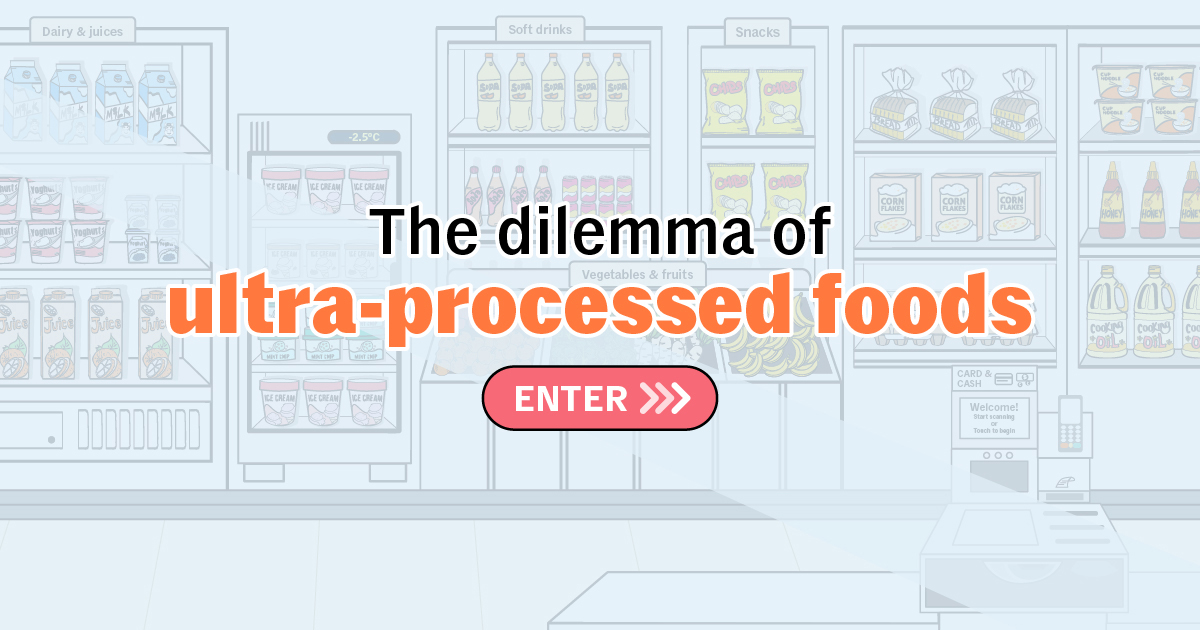Did you get what you expected?
Don’t worry if you got some items wrong. It’s not easy to tell what are UPFs from others.
These are all the UPFs on the shelves:(keep scrolling to read about them)
Are ultra-processed foods, linked by studies to weight gain, chronic disease and even early death, really that bad for our health?
By: Chew Hui Min | Published: Jun 20, 2025
Advancements in industrial techniques in the last 10 years have made packaged foods more processed and sophisticated.
UPFs are made to be highly convenient and ready to be consumed once purchased.
They are made to please all of one’s senses so consumers eat more, while low-cost ingredients and preservatives are used to lengthen shelf life and maximise profits for manufacturers.
This, in turn, has led scientists to develop the NOVA food classification system to better differentiate between “traditionally” processed foods and UPFs.
NOVA food classification
- 1 Unprocessed/minimally processed
- Foods unaltered or altered by processes such as removing inedible parts. No substances are added.
- Examples: Fresh/frozen fruits and vegetables, plain pasta
- 2 Processed culinary ingredients
- Substances from Group 1 or from nature, created by industrial processes such as pressing and extracting.
- Examples: Butter, honey, salt
- 3 Processed foods
- Products made by adding edible substances from Group 2 to Group 1 foods using preservation methods.
- Examples: Cured meats, canned vegetables in brine
- 4 Ultra-processed foods
- Formulations of low-cost substances derived from Group 1 foods. Always contain edible substances not used in home kitchens.
- Examples: Packaged snacks, candy, soft drinks, instant noodles
But not all scientists have agreed with this. Dr Kevin Hall, for one, found this definition confusing. He thought processed food was bad for you because they were high in fat, salt and sugar; and not because of the processing.
His 2019 study proved the opposite.
Dr Hall found that people ate more on an ultra-processed diet and gained weight, compared with a whole foods diet with similar calories and nutrients.
This journalist decided to try a mini-experiment: eating only ultra-processed foods on one day, and only whole foods on another, to feel the effects. She also logged her blood glucose readings throughout the day, using a wearable device.
- Health consultant’s notes
- Combined impact of refined carbohydrates in the bread and added sugars in the spread is seen in the spike
- Added flavouring in yoghurt and sugars in fruit juice also contributed to higher glucose level
I was not sure that one day would make much of a difference, but it did.
The first thing I noticed about UPFs was that they were soft. Bread from a supermarket and cup noodles did not require much chewing, compared with homemade bread and minimally processed noodles. This could be one reason why we eat more when eating processed food.
On the UPF diet, I consumed more than 2,300 calories. On a whole food diet, I took in about 1,600 calories, and felt fuller for longer.
I also felt dehydrated on UPFs. There was a persistent urge to drink water, especially after every meal.
While the food felt like flavour explosions in my mouth, the amount of salt and sugar sometimes felt too much to handle.
A pounding headache that hit me at the end of the day, while I was trying to write a news story, could also be linked to the diet. But there’s no way to tell for sure.
Scientists are still debating how exactly ultra-processed food affects our bodies. But such foods do make people eat more, gain weight and are linked to chronic diseases like diabetes, heart disease and cancer.
What then can we do to cut down on UPFs, despite their convenience and allure?
One can start by reading labels more carefully and being more aware of how much processed foods we are eating.
Assistant Professor Mary Chong said that people don’t realise the amount of UPFs creeping into the food they eat, given that these are easily available, affordable and advertised to both adults and children.
Unless people are well-aware about these foods, how to identify them and their ill-effects, the cumulative intake of UPFs over many years throughout the life course can lead to the manifestation of multiple chronic conditions such as obesity, diabetes, heart diseases and cancer in later life.
Asst Prof Mary Chong NUS’ Saw Swee Hock School of Public Health
Novi Health senior dietitian Joel Chia pointed out that increasing one’s protein intake such as fish, chicken and eggs goes a long way in helping to manage blood sugar and hunger levels. It would also help prevent sudden spikes and drop-offs in energy levels.
Take the whole foods-based dinner, for example. The buckwheat soba noodles, which are high in fibre and antioxidants, were paired with fish – a protein – and fresh vegetables (more fibre), making this a well-balanced meal, he noted.
While it’s unlikely we can avoid UPF completely, mixing it up with other healthier ingredients and foods is the first step towards avoiding the health risks such as cancer, heart disease and early death.
And that is a highly palatable proposition.
